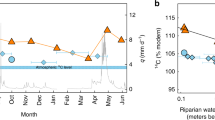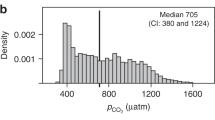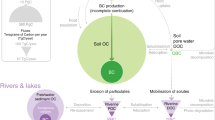Abstract
Terrestrial ecosystems in the humid tropics play a potentially important but presently ambiguous role in the global carbon cycle. Whereas global estimates of atmospheric CO2 exchange indicate that the tropics are near equilibrium or are a source with respect to carbon1,2, ground-based estimates indicate that the amount of carbon that is being absorbed by mature rainforests is similar to or greater than that being released by tropical deforestation3,4 (about 1.6 Gt C yr-1). Estimates of the magnitude of carbon sequestration are uncertain, however, depending on whether they are derived from measurements of gas fluxes above forests5,6 or of biomass accumulation in vegetation and soils3,7. It is also possible that methodological errors may overestimate rates of carbon uptake or that other loss processes have yet to be identified3. Here we demonstrate that outgassing (evasion) of CO2 from rivers and wetlands of the central Amazon basin constitutes an important carbon loss process, equal to 1.2 ± 0.3 Mg C ha-1 yr-1. This carbon probably originates from organic matter transported from upland and flooded forests, which is then respired and outgassed downstream. Extrapolated across the entire basin, this flux—at 0.5 Gt C yr-1—is an order of magnitude greater than fluvial export of organic carbon to the ocean8. From these findings, we suggest that the overall carbon budget of rainforests, summed across terrestrial and aquatic environments, appears closer to being in balance than would be inferred from studies of uplands alone3,5,6.
This is a preview of subscription content, access via your institution
Access options
Subscribe to this journal
Receive 51 print issues and online access
$199.00 per year
only $3.90 per issue
Buy this article
- Purchase on Springer Link
- Instant access to full article PDF
Prices may be subject to local taxes which are calculated during checkout




Similar content being viewed by others
References
Schimel, D. S. et al. Recent patterns and mechanisms of carbon exchange by terrestrial ecosystems. Nature 414, 169–172 (2001).
Gurney, K. R. et al. Towards robust regional estimates of CO2 sources and sinks using atmospheric transport models. Nature 415, 626–630 (2002).
Malhi, Y. & Grace, J. Tropical forests and atmospheric carbon dioxide. Trends Ecol. Evol. 15, 332–337 (2000).
Houghton, R. A. A new estimate of global sources and sinks of carbon from land-use change. Eos 81(Suppl.), S281 (2000).
Grace, J. et al. Carbon dioxide uptake by an undisturbed tropical rain forest in Southwest Amazônia, 1992 to 1993. Science 270, 778–780 (1995).
Malhi, Y. et al. Carbon dioxide transfer over a central Amazonian rain forest. J. Geophys. Res. 103, 31593–31612 (1998).
Phillips, O. L. et al. Changes in the carbon balance of tropical forests: Evidence from long-term plots. Science 282, 439–442 (1998).
Richey, J. E. et al. Biogeochemistry of carbon in the Amazon River. Limnol. Oceanogr. 35, 352–371 (1990).
Degens, E. T., Kempe, S. & Richey, J. E. (eds) Biogeochemistry of Major World Rivers 323–397 (Wiley, Chichester, 1991).
Sarmiento, J. L. & Sundquist, E. T. Revised budget for the oceanic uptake of anthropogenic carbon dioxide. Nature 356, 589–593 (1992).
Richey, J. E., Brock, J. T., Naiman, R. J., Wissmar, R. C. & Stallard, R. F. Organic carbon: oxidation and transport in the Amazon River. Science 207, 1348–1351 (1980).
Cole, J. J. & Caraco, N. F. Carbon in catchments: Connecting terrestrial carbon losses with aquatic metabolism. Mar. Freshwat. Res. 52, 101–110 (2001).
Kling, G. W., Kipphut, G. W. & Miller, M. C. Arctic lakes and streams and gas conduits to the atmosphere: implications for tundra carbon budgets. Science 251, 298–301 (1991).
Hope, D., Palmer, S. M., Billett, M. F. & Dawson, J. J. Carbon dioxide and methane evasion from a temperate peatland stream. Limnol. Oceanogr. 46, 847–857 (2001).
Telmer, K. & Veizer, J. Carbon fluxes, pCO2 and substrate weathering in a large northern river basin, Canada: carbon isotope perspectives. Chem. Geol. 159, 61–86 (1999).
McClain, M. E. & Richey, J. E. Regional-scale linkages of terrestrial and lotic ecosystems in the Amazon basin: A conceptual model for organic matter. Arch. Hydrobiol. 113 (Suppl.), 111–125 (1996).
Davidson, E. A. & Trumbore, S. E. Gas diffusivity and production of CO2 in deep soils of the eastern Amazon. Tellus B 47, 550–565 (1995).
Richey, J. E., Victoria, R. L., Mayorga, E., Martinelli, L. A. & Meade, R. H. in Biospheric Feedbacks in Climate and the Hydrological Cycle (ed. Kabat, P.) (Springer, in the press).
McClain, M. E., Richey, J. E., Brandes, J. A. & Pimentel, T. P. Dissolved organic matter and terrestrial-lotic linkages in the central Amazon Basin, Brazil. Glob. Biogeochem. Cycles 11, 295–311 (1997).
Melack, J. M. & Forsberg, B. R. in The Biogeochemistry of the Amazon Basin (eds McClain, M. E., Victoria, R. L. & Richey, J. E.) 235–274 (Oxford Univ. Press, New York, 2001).
Chambers, J. Q., dos Santons, J., Ribeiro, R. J. & Higuichi, N. Tree damage, allometric relationships, and above-ground net primary production in central Amazon forest. Forest Ecol. Management 5348, 1–12 (2000).
Devol, A. H., Forsberg, B. R., Richey, J. E. & Pimentel, T. P. Seasonal variation in chemical distributions in the Amazon (Solimões) River: a multiyear time series. Glob. Biogeochem. Cycles 9, 307–328 (1995).
Siqueira, P. et al. A continental-scale mosaic of the Amazon Basin using JERS-1 SAR. IEEE Trans. Geosci. Remote Sensing 38, 2638–2644 (2000).
Barbosa, C., Hess, L., Melack, J. & Novo, E. Mapping Amazon Basin wetlands through region-growing segmentation and segmented-based classification of JERS-1 data. IX Latin Am. Symp. Remote Sensing (6–10 November 2000) 1168–1176 (Universidad Nacional de Lujan, Puerto Iguazu, Argentina, 2000); see also 〈http://www.selper.org〉.
Hess, L. L. et al. Geocoded digital videography for validation of land cover mapping in the Amazon Basin. Int. J. Remote Sensing (in the press).
Sippel, S. J., Hamilton, S. K., Melack, J. M. & Novo, E. M. Passive microwave observations of inundation area and the area/stage relation in the Amazon River floodplain. Int. J. Remote Sensing 19, 3055–3074 (1998).
Richey, J. E., Devol, A. H., Wofsy, S. C., Victoria, R. & Ribeiro, M. N. G. Biogenic gases and the oxidation and reduction of carbon in the Amazon River and floodplain waters. Limnol. Oceanogr. 33, 551–561 (1988).
Devol, A. H., Quay, P. D., Richey, J. E. & Martinelli, L. A. The role of gas exchange in the inorganic carbon, oxygen and 222 radon budgets of the Amazon River. Limnol. Oceanogr. 32, 235–248 (1987).
Clark, J. F., Wanninkhof, R., Schlosser, P. & Simpson, H. J. Gas exchange rates in the tidal Hudson River using a dual tracer technique. Tellus B 46, 264–285 (1994).
MacIntyre, S., Eugster, W. & Kling, G. W. in Gas Transfer at Water Surfaces (eds Donelan, M. A., Drennan, W. M., Saltzman, E. S. & Wanninkhof, R.) 135–139 (American Geophysical Union, Washington, 2001).
Acknowledgements
We thank E. Mayorga, S. Denning, M. Gastil, D. Montgomery, R. Victoria, A. Krusche, A. Devol, P. Quay and J. Hedges for technical assistance and discussions, B. Forsberg and T. Pimental for fieldwork, and the Global Rain Forest Mapping Project of the National Space Development Agency of Japan for providing the JERS-1 radar data. This work was supported by the US NSF and NASA EOS and LBA projects, and by the Brazilian FAPESP programme.
Author information
Authors and Affiliations
Corresponding author
Ethics declarations
Competing interests
The authors declare that they have no competing financial interests
Rights and permissions
About this article
Cite this article
Richey, J., Melack, J., Aufdenkampe, A. et al. Outgassing from Amazonian rivers and wetlands as a large tropical source of atmospheric CO2. Nature 416, 617–620 (2002). https://doi.org/10.1038/416617a
Received:
Accepted:
Issue Date:
DOI: https://doi.org/10.1038/416617a
This article is cited by
-
Dissolved organic matter quantity and quality response of tropical rainforest headwater rivers to the transition from dry to wet season
Scientific Reports (2024)
-
Andean headwater and piedmont streams are hot spots of carbon dioxide and methane emissions in the Amazon basin
Communications Earth & Environment (2023)
-
A 30-year dataset of CO2 in flowing freshwaters in the United States
Scientific Data (2023)
-
Groundwater discharge contribution to dissolved inorganic carbon and riverine carbon emissions in a subarctic region
Biogeochemistry (2023)
-
Soil respiration and carbon stock responses to land use changes in the temperate forest of northern Iran
Environmental Earth Sciences (2023)
Comments
By submitting a comment you agree to abide by our Terms and Community Guidelines. If you find something abusive or that does not comply with our terms or guidelines please flag it as inappropriate.



